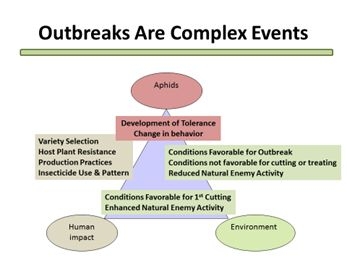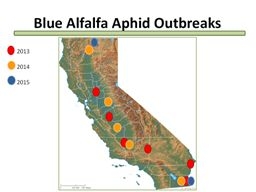Basic background and biology of the blue alfalfa aphid:
The blue alfalfa aphid (Acyrthosiphon kondoi Shinji) was first identified by entomologists in the spring of 1975 in the Imperial Valley of California. Since then it has become widespread throughout the state and has become established in Arizona, Nevada, New Mexico, and as far east as Kansas and Oklahoma. Both adults and nymphs feed on photosynthetic fluids from the leaves and stems of the alfalfa plant. Low to moderate populations of blue alfalfa aphid (BAA) may cause little to no visible yellowing of plants. Blue alfalfa aphid feed in the new growth, at the tips and young leaves. After prolonged feeding, leaves will eventually turn yellow, starting at the veins, leaves will curl and wilt, and turn necrotic (dead). Heavily damaged plants may become entirely defoliated except for a few leaves at the end of the stems - a result of the aphids moving higher into the plant. Under high aphid densities, growth is slowed after cutting. Infestation by weeds and general susceptibility to stress is increased; stand longevity may be decreased after damage by aphids.
Cooler weather is ideal for pea and blue alfalfa aphid population growth. Distinguishing between the pea and blue alfalfa aphid is critical for proper treatment (see Godfrey's blog here, //ucanr.edu/blogs/blogcore/postdetail.cfm?postnum=9639). Observation of the key characteristics can be done with a hand lens and using the ‘aphids found in alfalfa' key located here, http://ceriverside.ucanr.edu/newsletters/December_201034750.pdf. Both aphids are blue-greenish in color (the pea aphid has a “pinkish” biotype that is less common). The aphids are easily separated by looking at their antennae. The pea aphid has 3 to 4 narrow dark bands (annuli) along the antennae which are tan in color whereas the antennae of the blue alfalfa aphid are uniformly brown.
Blue alfalfa aphid first became an issue in 2013 when management with conventional insecticides became an issue. There were many thoughts on what was occurring at the time.
Possible factors for our BAA issue;
- High initial aphid populations
- Smaller than expected populations of predators and parasites; particularly the seven-spotted lady beetle
- May be weather related or pesticide related (see //ucanr.edu/blogs/blogcore/postdetail.cfm?postnum=9640)
- Potentially more insecticides used in alfalfa than in the past; partially due to cowpea aphid and/or Egyptian alfalfa weevil early in the season
- Lack of “bio-rational” products for weevil and aphid management in alfalfa
- Growers are spraying at the time of year when there are the fewest beneficial insects in alfalfa. The insecticides along with cool weather may be preventing or delaying the buildup of beneficial insect populations
- Biologically unique “biotype” of blue alfalfa aphid which may explain field to field variation within an area
Since that time the BAA “problem” has not only been persistent in California's Southern desert but has expanded to Northern California.
Management of BAA has always relied on a combination of tactics (AKA “tools”) a cornerstone of an Integrated Pest Management program. Given the ability of aphids to quickly adapt to adverse conditions, reliance on a single management tool is unsustainable. For this pest, three approaches are important to consider.
1) Maintaining or augmenting levels of natural enemies; including parasitoids, predators and fungal diseases of aphids which can provide biological suppression of pest populations.
2) Development and use of host plant resistance; an important management tool since limited BAA resistance has been bred into many alfalfa varieties which reduces BAA's ability to infest and reproduce on them. You can refer to the link here http://alfalfa.org/varietyLeaflet.php for the Alfalfa Variety Winter Survival, Fall Dormancy & Pest Resistance Ratings for Alfalfa Varieties 2015 Edition.
3) Use of insecticides; a useful “tool” with several insecticides registered for BAA in alfalfa
Links to recent articles on blue alfalfa aphid;
//ucanr.edu/blogs/blogcore/postdetail.cfm?postnum=12614
//ucanr.edu/blogs/blogcore/postdetail.cfm?postnum=10422
//ucanr.edu/blogs/blogcore/postdetail.cfm?postnum=9786